外研版必修三Unit4Amazing art Developing ideas 精品英语课件(共24张PPT)
文档属性
| 名称 | 外研版必修三Unit4Amazing art Developing ideas 精品英语课件(共24张PPT) | 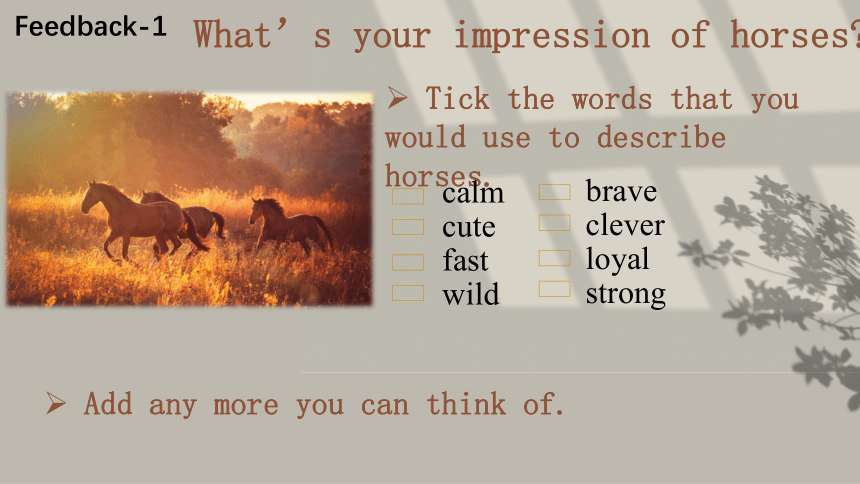 | |
| 格式 | pptx | ||
| 文件大小 | 8.5MB | ||
| 资源类型 | 教案 | ||
| 版本资源 | 外研版(2019) | ||
| 科目 | 英语 | ||
| 更新时间 | 2023-03-27 15:24:30 | ||
图片预览

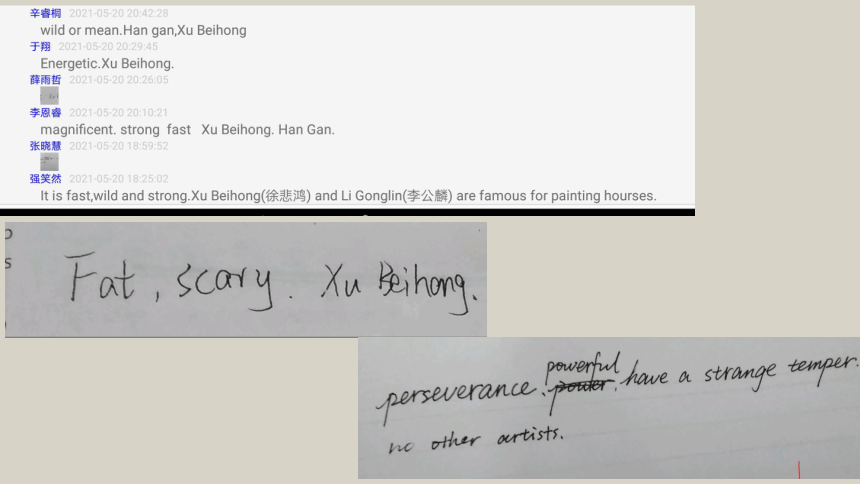
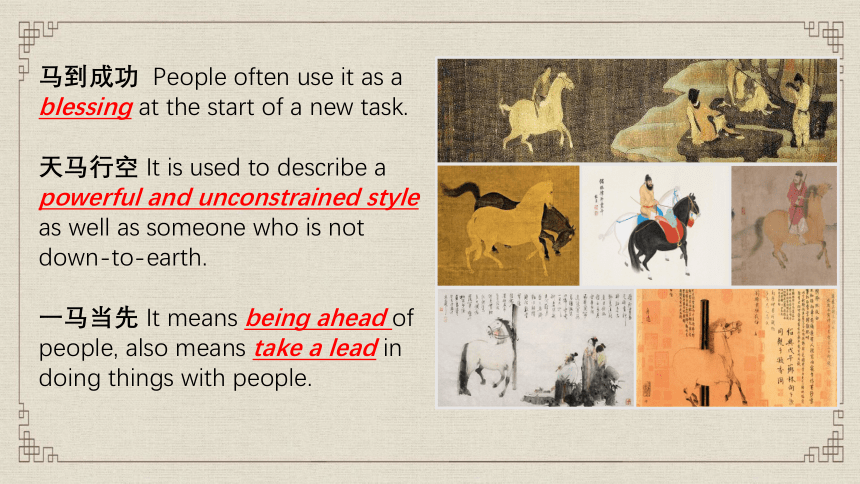
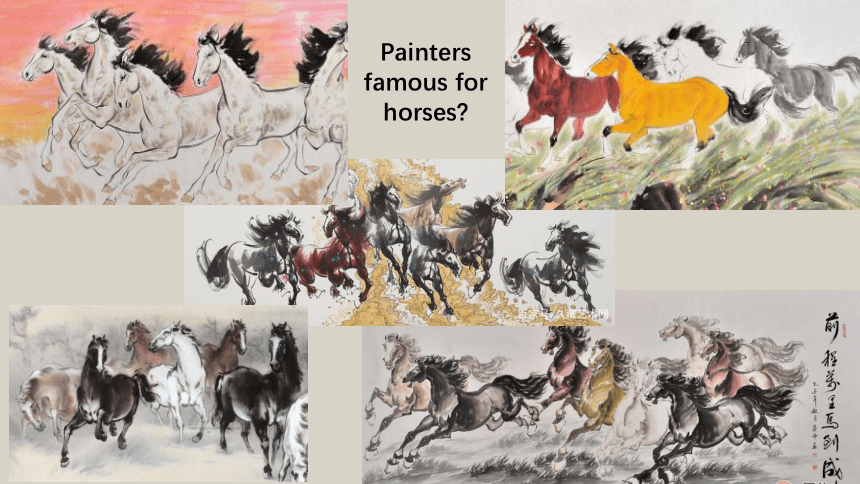
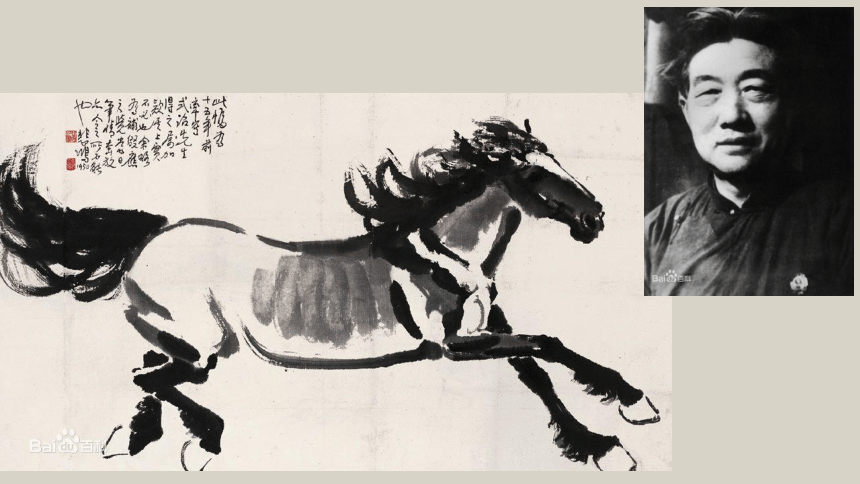

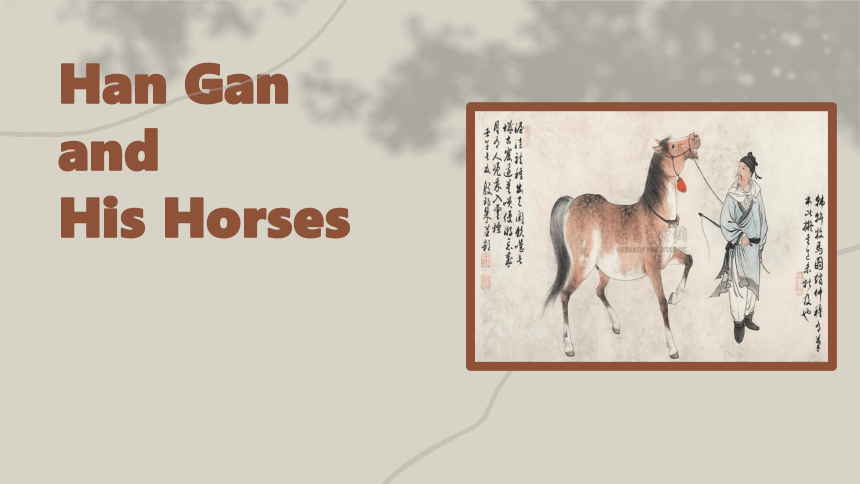
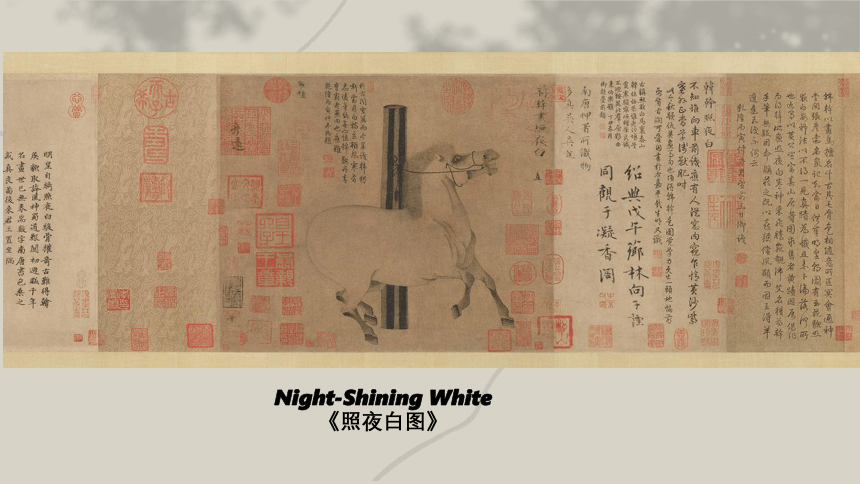
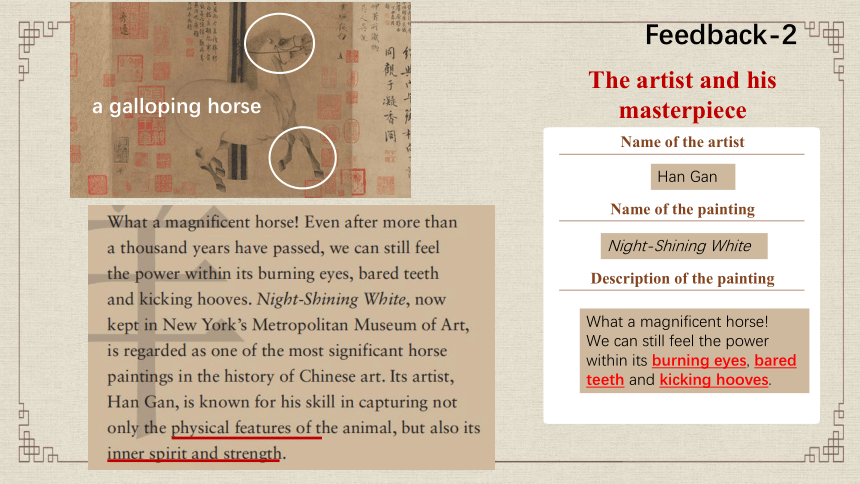
文档简介
(共24张PPT)
What’s your impression of horses
Tick the words that you would use to describe horses.
calm
cute
fast
wild
brave
clever
loyal
strong
Add any more you can think of.
Feedback-1
马到成功 People often use it as a blessing at the start of a new task.
天马行空 It is used to describe a powerful and unconstrained style as well as someone who is not down-to-earth.
一马当先 It means being ahead of people, also means take a lead in doing things with people.
Painters famous for horses
《五马图一:凤头骢》
《五马图二:锦膊骢》
《五马图三:好头赤》
《五马图四:照夜白 》
《五马图五:满川花 》
李公麟 北宋
Han Gan
and
His Horses
Night-Shining White
《照夜白图》
galloping horse
The artist and his masterpiece
Name of the artist
Name of the painting
Description of the painting
a galloping horse
Han Gan
Night-Shining White
What a magnificent horse!
We can still feel the power within its burning eyes, bared teeth and kicking hooves.
Feedback-2
The life of the artist
Personal information
(birth, dynasty, etc)
How he became a painter
What he did as a court painter
He was born into a poor family in the early Tang Dynasty.
His artistic talent was discovered by the poet Wang Wei. He sponsored Han Gan to study painting and recommended him to a master. Due to Han Gan’s natural talent and years of hard work, he was eventually chosen to serve Emperor Xuanzong in the royal palace.
The life of the artist
Personal information
(birth, dynasty, etc)
How he became a painter
What he did as a court painter
He frequently visited the royal stables and even moved in to live with the stable workers for quite some time in order to observe horses.
“臣自有师,陛下内厩之马,皆臣之师也。”
Comments on his work
Other viewers
Su Shi
“The horses painted by Han Gan are real horses.”
“Han Gan’s horses could gallop off the paper.”
“韩生画马真是马,苏子作诗如见画”
What makes Han Gan a successful painter?
to pay the costs
recognition
an innovative painter
careful observation
hard practice
It's his innovative method, careful observation and hard practice that make him a successful painter.
inspiration from life
talent
Han Gan and His Horses
The artist and his masterpiece
The life of the artist
Comments on his work
Paragraph ____
Paragraph ____
Divide the passage into several parts
Paragraph ____
1
2-4
5
A designer can use default text to simulate what text would look like. If it is not real text. A designer can use default text to simulate what text would look like.
An introduction to the Metropolitan Museum of Art.
The story behind Night-Shining White.
The famous artist Han Gan.
法式复古田园风
What is the passage mainly about
Imagine you are a tour guide in the Metropolitan Museum of Art. Talk about the life and work of Han Gan.
Role A: a tour guide 【introduce Han Gan and background to visitors】
Role B: a blogger who is making a live broadcast 【imitate Zack’s broadcast to introduce this painting to your viewers】
Role C, D, E, F: visitors 【express your feelings and comments about this painting】
A leading horse painter of the Tang dynasty, Han Gan was known for capturing not only the likeness of a horse but also its spirit. This painting, the most famous work attributed to(归属于) the artist, is a portrait of a charger(战马) of Emperor Xuanzong (r. 712–56). With its burning eye, flaring nostrils, and dancing hoofs, the fiery-tempered horse epitomizes (成为…的典范)Chinese myths about Central Asian "celestial steeds"(天马) that "sweated blood"(血汗) and were actually dragons in disguise(伪装). The seals and inscriptions(题词) added to the painting and its borders by later owners and appreciators are a distinctive feature of Chinese collecting and connoisseurship(鉴赏). The addition of more than one thousand years of seals and comments offers a vivid testimony(证据) of the work's transmission(传播) and its impact on later generations.
What a magnificent horse! Even after more than a thousand years have passed, we can still feel the power within its burning eyes, bared
teeth and kicking hooves. Night-Shining White, now kept in New York’s
Metropolitan Museum of Art, is regarded as one of the most
significant horse paintings in the history of Chinese art. Its artist, Han Gan, is known for his skill in capturing not only the physical features of
the animal, but also its inner spirit and strength.
感叹句:how/what
pass (v) 时间流逝 = go by
=which is now kept in…, 此处过去分词作后置定语
被认作/被视为…
(v.) 捕捉
Born into a poor family in the early Tang Dynasty, the young Han Gan had to help support his family by working in a local wine shop. His artistic talent was discovered by accident when he was sent to
the poet Wang Wei’s house to collect payment for some wine.
be born into/to…:…出身(表示社会背景或家境)
She was born to riches/wealth. = She was born into a rich/wealthy family.
She was born to teach. = She was born to be a teacher.
偶然、意外地=by chance = accidentally
故意地: on purpose = by design = deliberately
收款
I collected the rent from the tenants.我从房客那儿收取了租金。
She collects social security benefits.她会收到社会保障福利金。
While waiting at the gate, Han Gan used a stick to draw pictures in
the dirt and was seen by the poet himself. Wang Wei decided to sponsor the young man to study painting and recommended him to
a master. Due to Han Gan’s natural talent and years of hard work, he was eventually chosen to serve Emperor Xuanzong in the royal palace.
while 引导时间状语从句的省略
While Han Gan was waiting..
在大门口
资助某人做某事
向某人推荐…
(n.) recommendation
She dedicated her whole life to serving God.她把一生都用来侍奉上帝。
He served as the club's adviser.他担任过该俱乐部的顾问。
The waiter served our meals quickly.这名侍应生给我们上菜非常快。
Two elementary schools serve the town.这个镇有两所小学。
If (my) memory serves me (right/correctly), she is from Los Angeles.
由于
=owing to, on account of, because of
The Tang emperors were very fond of horses. This meant that the animal was a frequent subject for artists. At that time, the most common way to study horse painting was by copying the works of previous painters. Han Gan’s method, however, was different - he observed the animal itself. He was a frequent visitor to the royal stables and even moved in to live with the stable workers for quite some time. The horses, whether resting or on the move, offered him
plenty of inspiration. The more time he spent observing these animals, the more his understanding of them grew. Day after day, Han Gan painted the horses, his brush presenting every detail that he saw with his own eyes.
独立主格结构(作状语): 名词+不定式/ing分词/ed分词/形容词/副词/介词短语
【比较】with复合结构?
在行进/移动中
It is said that when the Emperor asked Han Gan to take a master of horse painting as his teacher, the artist replied, “I have my own teachers, Your Majesty. All the horses in your stables are my very teachers.”
Those who saw Han Gan’s horse paintings all sang high praises for
his unique skill, saying that his horses “could gallop off the paper”. Even Su Shi, the famous poet of the Song Dynasty, expressed his admiration for Han Gan as a master of horse painting with the words, “The horses painted by Han Gan are real horses.”
据说…
very (adj.) (特指某事或某一部分)正是的,恰好的,同一的
There's the very book I was looking for.这正是我要找的那本书。
sing high praises for …高度赞颂…
= speak/think highly of sth
admire (v.)羡慕,钦佩
What’s your impression of horses
Tick the words that you would use to describe horses.
calm
cute
fast
wild
brave
clever
loyal
strong
Add any more you can think of.
Feedback-1
马到成功 People often use it as a blessing at the start of a new task.
天马行空 It is used to describe a powerful and unconstrained style as well as someone who is not down-to-earth.
一马当先 It means being ahead of people, also means take a lead in doing things with people.
Painters famous for horses
《五马图一:凤头骢》
《五马图二:锦膊骢》
《五马图三:好头赤》
《五马图四:照夜白 》
《五马图五:满川花 》
李公麟 北宋
Han Gan
and
His Horses
Night-Shining White
《照夜白图》
galloping horse
The artist and his masterpiece
Name of the artist
Name of the painting
Description of the painting
a galloping horse
Han Gan
Night-Shining White
What a magnificent horse!
We can still feel the power within its burning eyes, bared teeth and kicking hooves.
Feedback-2
The life of the artist
Personal information
(birth, dynasty, etc)
How he became a painter
What he did as a court painter
He was born into a poor family in the early Tang Dynasty.
His artistic talent was discovered by the poet Wang Wei. He sponsored Han Gan to study painting and recommended him to a master. Due to Han Gan’s natural talent and years of hard work, he was eventually chosen to serve Emperor Xuanzong in the royal palace.
The life of the artist
Personal information
(birth, dynasty, etc)
How he became a painter
What he did as a court painter
He frequently visited the royal stables and even moved in to live with the stable workers for quite some time in order to observe horses.
“臣自有师,陛下内厩之马,皆臣之师也。”
Comments on his work
Other viewers
Su Shi
“The horses painted by Han Gan are real horses.”
“Han Gan’s horses could gallop off the paper.”
“韩生画马真是马,苏子作诗如见画”
What makes Han Gan a successful painter?
to pay the costs
recognition
an innovative painter
careful observation
hard practice
It's his innovative method, careful observation and hard practice that make him a successful painter.
inspiration from life
talent
Han Gan and His Horses
The artist and his masterpiece
The life of the artist
Comments on his work
Paragraph ____
Paragraph ____
Divide the passage into several parts
Paragraph ____
1
2-4
5
A designer can use default text to simulate what text would look like. If it is not real text. A designer can use default text to simulate what text would look like.
An introduction to the Metropolitan Museum of Art.
The story behind Night-Shining White.
The famous artist Han Gan.
法式复古田园风
What is the passage mainly about
Imagine you are a tour guide in the Metropolitan Museum of Art. Talk about the life and work of Han Gan.
Role A: a tour guide 【introduce Han Gan and background to visitors】
Role B: a blogger who is making a live broadcast 【imitate Zack’s broadcast to introduce this painting to your viewers】
Role C, D, E, F: visitors 【express your feelings and comments about this painting】
A leading horse painter of the Tang dynasty, Han Gan was known for capturing not only the likeness of a horse but also its spirit. This painting, the most famous work attributed to(归属于) the artist, is a portrait of a charger(战马) of Emperor Xuanzong (r. 712–56). With its burning eye, flaring nostrils, and dancing hoofs, the fiery-tempered horse epitomizes (成为…的典范)Chinese myths about Central Asian "celestial steeds"(天马) that "sweated blood"(血汗) and were actually dragons in disguise(伪装). The seals and inscriptions(题词) added to the painting and its borders by later owners and appreciators are a distinctive feature of Chinese collecting and connoisseurship(鉴赏). The addition of more than one thousand years of seals and comments offers a vivid testimony(证据) of the work's transmission(传播) and its impact on later generations.
What a magnificent horse! Even after more than a thousand years have passed, we can still feel the power within its burning eyes, bared
teeth and kicking hooves. Night-Shining White, now kept in New York’s
Metropolitan Museum of Art, is regarded as one of the most
significant horse paintings in the history of Chinese art. Its artist, Han Gan, is known for his skill in capturing not only the physical features of
the animal, but also its inner spirit and strength.
感叹句:how/what
pass (v) 时间流逝 = go by
=which is now kept in…, 此处过去分词作后置定语
被认作/被视为…
(v.) 捕捉
Born into a poor family in the early Tang Dynasty, the young Han Gan had to help support his family by working in a local wine shop. His artistic talent was discovered by accident when he was sent to
the poet Wang Wei’s house to collect payment for some wine.
be born into/to…:…出身(表示社会背景或家境)
She was born to riches/wealth. = She was born into a rich/wealthy family.
She was born to teach. = She was born to be a teacher.
偶然、意外地=by chance = accidentally
故意地: on purpose = by design = deliberately
收款
I collected the rent from the tenants.我从房客那儿收取了租金。
She collects social security benefits.她会收到社会保障福利金。
While waiting at the gate, Han Gan used a stick to draw pictures in
the dirt and was seen by the poet himself. Wang Wei decided to sponsor the young man to study painting and recommended him to
a master. Due to Han Gan’s natural talent and years of hard work, he was eventually chosen to serve Emperor Xuanzong in the royal palace.
while 引导时间状语从句的省略
While Han Gan was waiting..
在大门口
资助某人做某事
向某人推荐…
(n.) recommendation
She dedicated her whole life to serving God.她把一生都用来侍奉上帝。
He served as the club's adviser.他担任过该俱乐部的顾问。
The waiter served our meals quickly.这名侍应生给我们上菜非常快。
Two elementary schools serve the town.这个镇有两所小学。
If (my) memory serves me (right/correctly), she is from Los Angeles.
由于
=owing to, on account of, because of
The Tang emperors were very fond of horses. This meant that the animal was a frequent subject for artists. At that time, the most common way to study horse painting was by copying the works of previous painters. Han Gan’s method, however, was different - he observed the animal itself. He was a frequent visitor to the royal stables and even moved in to live with the stable workers for quite some time. The horses, whether resting or on the move, offered him
plenty of inspiration. The more time he spent observing these animals, the more his understanding of them grew. Day after day, Han Gan painted the horses, his brush presenting every detail that he saw with his own eyes.
独立主格结构(作状语): 名词+不定式/ing分词/ed分词/形容词/副词/介词短语
【比较】with复合结构?
在行进/移动中
It is said that when the Emperor asked Han Gan to take a master of horse painting as his teacher, the artist replied, “I have my own teachers, Your Majesty. All the horses in your stables are my very teachers.”
Those who saw Han Gan’s horse paintings all sang high praises for
his unique skill, saying that his horses “could gallop off the paper”. Even Su Shi, the famous poet of the Song Dynasty, expressed his admiration for Han Gan as a master of horse painting with the words, “The horses painted by Han Gan are real horses.”
据说…
very (adj.) (特指某事或某一部分)正是的,恰好的,同一的
There's the very book I was looking for.这正是我要找的那本书。
sing high praises for …高度赞颂…
= speak/think highly of sth
admire (v.)羡慕,钦佩
